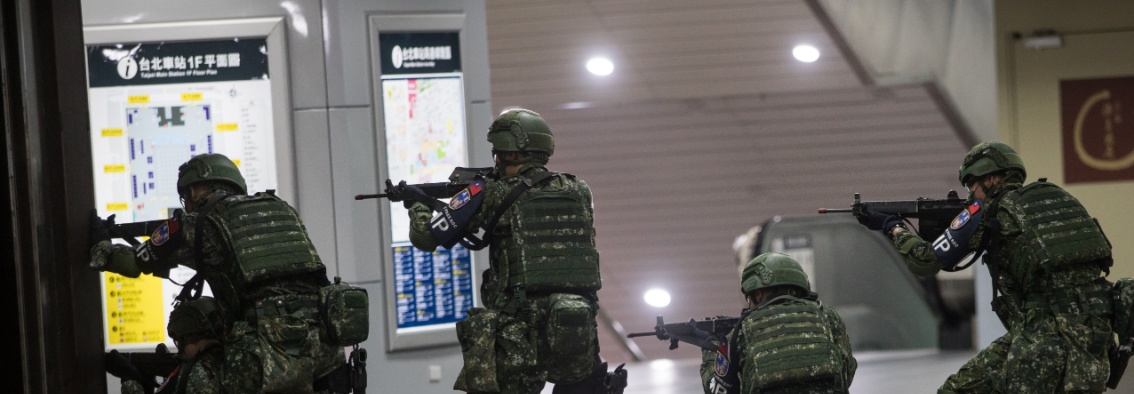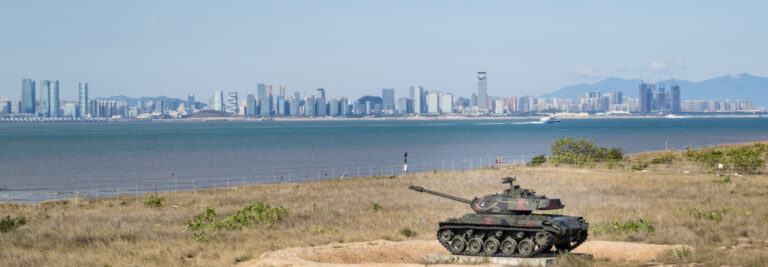From July 9-18, Taiwan’s military and other supporting government agencies conducted this year’s iteration of the Han Kuang exercise (漢光演習)—a military exercise conducted every year since 1984 to simulate the response to an invasion of Taiwan, and the largest single event on the annual calendar of the Republic of China (ROC) Ministry of National Defense (MND, 國防部). [1] Iterations of Han Kuang in recent years had followed a roughly similar schedule of events: often opening with ship and aircraft dispersals to simulate platform preservation operations in the face of missile attacks; followed by live-fire exercises (especially on outer islands) and simulated anti-landing defense operations; anti-terrorism / anti-infiltration drills at transportations hubs like airports and train stations; and civil defense drills to simulate sheltering against air attacks. [2]
Although Han Kuang represents one of the few opportunities for the ROC armed forces to conduct island-wide training for a wartime scenario, past iterations of the exercise have been criticized on the grounds of being overly-scripted, and for lacking meaningful training for the participating personnel—a series of events organized more as a public relations performance than as a serious exercise. [3] The 2024 iteration of Han Kuang had promised a new approach—one that would be less scripted and more decentralized. However, the abortive early end of the 2024 exercise due to a typhoon made it difficult to effectively evaluate how much had really changed.
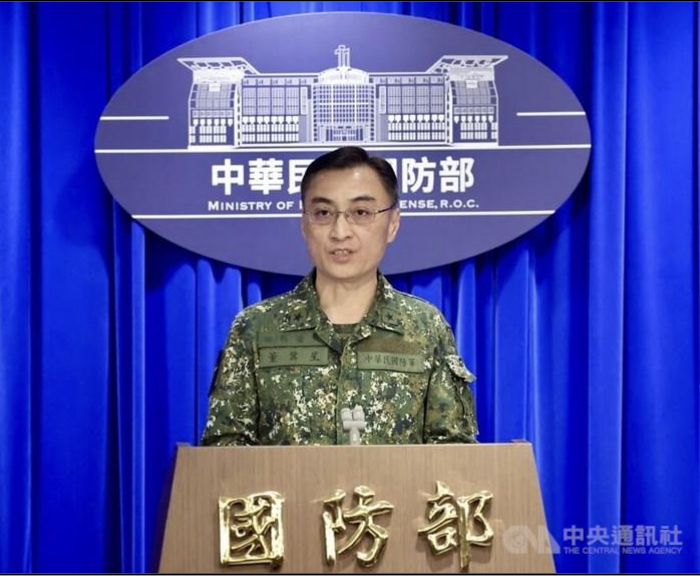
Image: ROC Army Major General Tung Chi-hsing (董冀星), director of the MND’s joint operations planning division, speaking at an early April press conference about the upcoming 2025 Han Kuang exercise. (Image source: Central News Agency)
Prior to the start of this year’s exercise, MND spokespeople similarly heralded a new approach: promising an exercise that would be double the length of previous years, provide a greater role for both reservists and civil defense personnel, and be less scripted than the performance-like exercises of previous years. Speaking prior to the exercise on July 1, ROC Army Major General Tung Chi-hsing (董冀星), director of the MND’s joint operations planning division, described a planned breakdown of the exercise into three phases: with the first three days (July 9-11) focused on the response to adversary gray zone operations; a transitional “force deployment” phase on July 12; then a “full scale combat” phase (July 13-18) that would include anti-landing operations (July 13), coastal combat (July 14), defense in-depth operations (July 15-16), and then “protracted warfare” (July 17-18) to round out the exercise.
Building upon a trend first noted in the 2022 iteration of Han Kuang, the 2025 Han Kuang was also noteworthy for the largest number of reservists (22,000) ever called up for training. This represents an effort to address the severe weaknesses of Taiwan’s reserve system—which possesses a large number of potential troops on paper, although those reserve soldiers receive little in the way of meaningful training. As one reservist reporting for duty in this year’s exercise commented to media, “I haven’t trained in five years, and this is the first time I’ve been summoned” for duty—an indictment of the lack of seriousness displayed in the past for the management of the ROC Army reserve system. This year’s exercise, which reportedly allowed for the deployment of reserve soldiers in brigade-size elements, is a further step in the right direction of making reserve training more rigorous and meaningful.
This year’s exercise was more ambitious, and markedly different in many aspects, from past iterations of Han Kuang. This article is intended to provide both a summary overview of the major training evolutions of the exercise, as well as its points of departure from past years—and what this might mean in a larger sense for the training conducted by Taiwan’s armed forces to repel an actual invasion. [3]
An Overview of Major Events in Han Kuang 2025
Phase 1: Gray Zone Simulations, Preparatory Deployments, and Weapon Test Firings (July 9-11)
July 9
The opening phase of this year’s Han Kuang exercise focused on a mix of preparatory unit maneuvers and defensive staging, in tandem with a maritime gray zone scenario. Although details are lacking, scenarios were reportedly held involving simulated People’s Republic of China (PRC) Coast Guard vessels and maritime militia boats engaging in operations near Taiwan-controlled territory, with ROC Navy assets deploying to unspecified locations as a precautionary measure in the event of a larger conflict. Navy mobile radar units and anti-ship cruise missile (ASCM) systems were also dispatched to forward deployment locations. Army engineers also began the construction of anti-landing obstacles on selected beaches deemed to be potential sites for enemy amphibious operations.
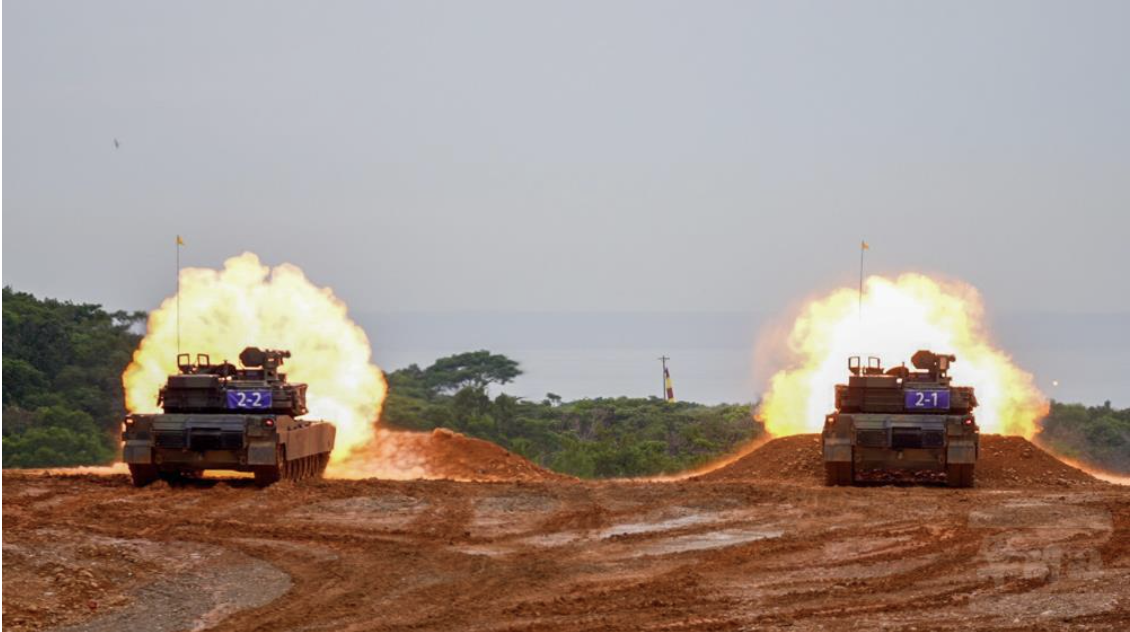
Image: M1A2T tanks from the ROC Army’s 584th Armored Brigade conduct test firings at the Kengzikou Training Ground near Hsinchu during the Han Kuang exercise (July 10). (Image source: ROC Military News Agency)
July 10
Highlights of the exercise on July 10 included a test-firing evolution at the Keng-zi Kou Training Facility (坑子口訓練場) in Hsinchu County, involving M1A2T tanks purchased from the United States. This evolution, though not officially part of Han Kuang, was observed by President Lai Ching-te (賴清德). The day also saw the deployment of two of the navy’s Tuo Chiang (沱江)-class ships, the An Chiang (安江) and Ta Chiang (塔江艦), to the east coast port of Hualien, ostensibly for the purpose of monitoring People’s Liberation Army (PLA) Navy ships operating to the east of Taiwan.
July 10 also saw combat readiness exercises on the Taiwan-administered offshore islands of Matsu and Penghu. The latter case reportedly involved a “counter-sabotage support mission” by the island’s personnel, involving both the personnel of the ROC Army Penghu Defense Command and “garrison troops” (one year conscript personnel). July 10 also saw the repeat of a standard part of Han Kuang exercises in recent years, with the dispersal of ROC Air Force aircraft from bases in western Taiwan to sheltered locations in western Taiwan, simulating efforts to preserve these assets in the face of Chinese missile attacks.
Following a pattern from past exercises, July 10 also featured a scenario to simulate defense of one of Taiwan’s major airports from enemy attack. Soldiers of the ROC Army’s 269th Mechanized Infantry Brigade—operating three CM11 tanks and three CM22 mortar carrier vehicles, and other supporting vehicles—set up defensive positions near Taoyuan International Airport (臺灣桃園國際機場), to stage a defense against airborne or airmobile assaults intended to seize the airport.
July 11
July 11 featured one of the more significant training evolutions for reserve soldiers in the exercise. More than 3,000 reservists were assigned to the ROC Army’s 206th Infantry Brigade, and conducted training in the vicinity of Taoyuan. On July 11 some of these reservists simulated the defense of a logistics site in Taoyuan from a simulated attack by Chinese agents. The training evolution reportedly included elements such as loudspeakers to produce gunfire sounds, and multi-colored smoke, to simulate battle conditions.

Image: Reservists assigned to the ROC Army’s 206th Infantry Brigade conduct a training evolution simulating the defense of a logistics site in Taoyuan (July 11). (Image source: Central News Agency)
Phase 2: Transition to Full Scale Invasion and Larger-Scale Combat Operations (July 12-14)
July 12
On July 12, the military began to transition from practicing a response to gray zone operations, to defending against a full-scale invasion wherein the PLA successfully gained control of a beachhead. For the coastal defense scenarios, the ROC military focused on two primary areas: the Taichung area, which saw test firings of the High Mobility Artillery Rocket System (HIMARS); and defense of landing locations on the Tamsui River (淡水河) outside of Taipei.
Near Taiwan’s western coast in the vicinity of Taichung, the ROC Army conducted test firings of its newly-acquired US-made HIMARS—a weapon system with an effective range of 300 kilometers (190 miles), which allows it to strike targets as far as Fujian’s coast. (Taiwan received its first batch of eleven HIMARS late last year from an order it placed in 2019. The order, which has 18 outstanding units, is on track to be completed by 2026.) HIMARS are also compatible with Taiwan’s indigenous Thunderbolt 2000 launcher (雷霆2000), meaning that the military can better integrate the HIMARS with its own systems. This demonstrates the first time the military has publicly tested this weapon.
Meanwhile, in northern Taiwan the ROC Army’s 53rd Engineer Group placed obstacles in the mouth of the Tamsui River—a strategic waterway that would prove crucial to transporting a PLA landing force in Taipei. The army built three defensive lines in the river with “blocking chains” comprising gasoline barrels and live C4 explosives.
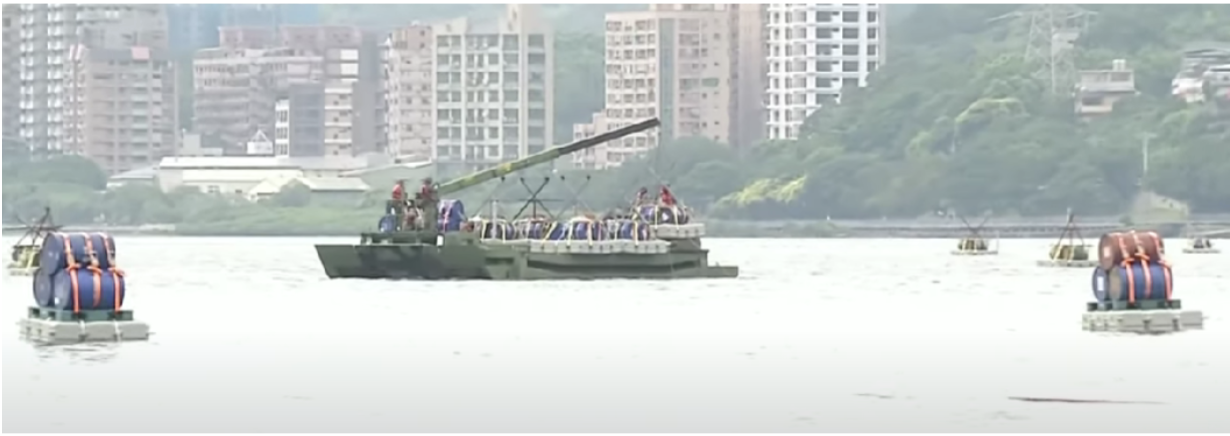
Image: Personnel of the ROC Army’s 53rd Engineer Group place obstacles in the Tamsui River (northern Taiwan) to block access to the river by enemy amphibious forces (July 12). (Image source: TaiwanPlus News)
July 13
In the Taipei area, the ROC Army 21st Artillery Command performed short to medium-range missile air defense drills near Taoyuan International Airport using indigenous Land Sword II (陸劍二) and Sky Sword II (天劍二) missiles.
In Taichung, the ROC Army Fifth Theater Command practiced fortifying coastal landing sites with wave breakers, barbed wire, and tank ditches. For the first time, the army used US-made Hesco bastions—portable sand-filled barriers the US military heavily used in Afghanistan and Iraq, which require only two people and an excavator for setup. After fortifying the beachheads, the military then conducted live-fire anti-landing and road denial exercises.
In Tainan, the ROC Army 54th Engineer Group rapidly built defensive fortifications downtown overnight to block simulated enemy advances. The nighttime exercise, which ended by 5:00 AM on July 14, saw the soldiers deploy barbed wire, “Czech hedgehogs,” and civilian vehicles as makeshift barricades. Further to the south, the Marine Corps’ 99th Brigade, stationed in Kaohsiung, simulated rapidly transporting HUMVEEs and other tactical vehicles north to fortify Taipei. The drill, which began late at night on July 12, concluded in the early morning on July 13.
Military personnel on Taiwan’s outlying islands also conducted major exercises on July 13. In Penghu County (澎湖縣), the military simulated defense operations against a PLA beach landing and airborne assault on the Penghu Airport.
July 14
On July 14, military police carried out urban combat drills in Taipei in the area between Shandao Temple Station (善導寺站) and Longshan Temple Station (龍山寺站) and practiced using the metro (MRT) for rapid deployment to meet enemy forces.
From 11:00 PM July 14 through 6:00 AM on July 15, the 202nd Military Police Command carried out an extensive transportation closure exercise on the Wanban Bridge (萬板大橋), a strategic point that connects the Wanhua District of Taipei with the Banqiao District of New Taipei City. This was the first time that the bridge—a major transit artery in the capital area—was completely closed to traffic. In the drill, the military simulated a PLA ground assault pushing its way into Taipei proper. By 1:00 AM military police completed a four-tiered series of obstacles that incorporated military equipment with civilian infrastructure and vehicles. These included roadblocks, razor wire, local buses, and Hesco barriers. In addition, the military used small reconnaissance drones to detect enemy locations before engaging—a tactic the military learned from observing the Ukraine war. In the simulation the PLA broke through the first three barriers before Taiwanese snipers and armored vehicles neutralized them.
To the south in Kaohsiung, the ROC Navy’s 192nd Fleet mine-laying unit practiced a mine-laying exercise in the vicinity of Tsuo-ying Naval Base (左營海軍基地), simulating the defense of the area against an amphibious invasion. This scenario was observed by President Lai, who also visited one of the mine-laying ships.
Phase 3: Urban Warfare and Civilian Operations (July 15-18)
July 15
July 15 marked the beginning of the urban warfare and civilian operations phase. In this phase, the military simulated the PLA gaining footholds further inland and in major cities like Taipei. Like the previous phase, this was a new feature that was not present in previous Han Kuang iterations.
Military operations on July 15 included several drills including simulated amphibious assaults on key ports and outlying islands. Additionally, the ROC Navy began major missile testing operations. The navy’s Hai Feng shore-based Anti-Ship Missile Group (海鋒大隊) tested four launch vehicles with some debuting the new extended range Hsiung Feng III (HF-III) (雄風三型) medium range anti-ship cruise missile, Taiwan’s first supersonic missile.
In New Taipei, the 269th Mechanized Infantry Brigade defended against a simulated amphibious PLA landing in the port of Taipei. ROC Army infantry and armor carried out similar drills in Penghu and Matsu. Building off the previous day’s Wanban Bridge exercise, units on Kinmen conducted a similar defense drill on Kinmen Bridge (金門大橋).
Additionally, this year’s drill fully integrated the Wan An (萬安演習) and Min An (民安演習) civil defense drills under the umbrella of a concurrent “2025 Urban Resilience (Counter Air Attack) Exercise” [2025城鎮韌性(防空)演習] that tested different regions each day. In parallel with the military drills, urban resilience drills began in Central Taiwan in Taichung, Miaoli County, Nantou County, and Changhua County.
July 16
July 16 featured three prominent drills: unannounced overnight anti-airborne drills in Taipei’s Songshan International Airport (臺北松山機場), rapid in-theater tank repairs, and the navy simulating escorting allied vessels into Hualien. Late at night, adversary forces executed an unannounced simulated airmobile assault on the Songshan Airport, a scenario intended to test defending forces’ capabilities under an unexpected and disadvantageous situation.
In Taoyuan the ROC Army’s 584th Armored Brigade practiced repairing its M88A1 tanks while in combat. During the drill, random tanks were designated as broken down, with forward support teams deployed to fix them on scene within 30 minutes.
On the east coast, the ROC Navy practiced maintaining an open corridor for allied vessels to enter the port facility of Hualien (花蓮港). As part of this, the navy built makeshift defenses involving two Tuo Chiang-class corvettes and anti-air units stationed around the port and simulated escorting ships from a US Navy carrier group that entered the port at 6:00 AM.
Local government officials also conducted urban resilience drills in southern Taiwan in the following locations: Kaohsiung, Pingtung County, and Tainan (the latter exempt due to Typhoon Danas recovery efforts).
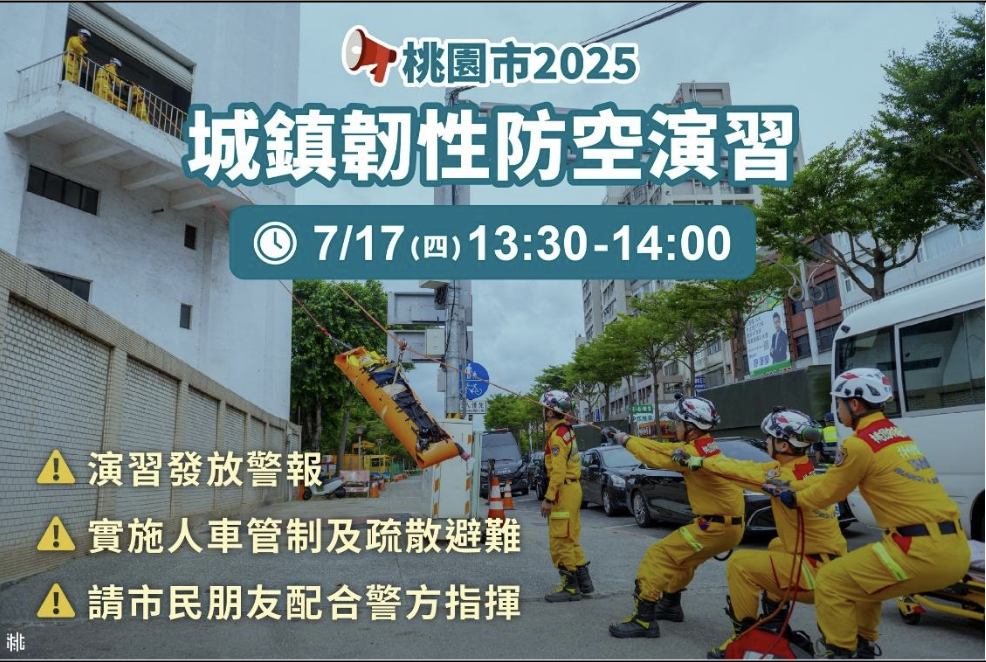
Image: A social media graphic publicizing the “City and Town Resilience / Counter Air Attack Exercise” civil defense drills to be held in Taoyuan on July 17 as a component of the larger Han Kuang exercise. (Image source: Taoyuan Events (桃園事) Facebook)
July 17
July 17 simulated continued PLA attacks on Matsu Island, and advances into Taipei and other major cities.
In Matsu, the military practiced defending critical energy infrastructure, particularly oil tanks. The Matsu Defense Command (馬祖防衛指揮部), in conjunction with local first responders, responded to a mock enemy infiltration and sabotage operation at the Beigan Power Plant (北竿發電廠).
On the main island of Taiwan, in Taichung the ROC Army’s 602nd Aviation Brigade and Taipei’s 601st Aviation Brigade simulated combat operations after PLA penetration into their respective downtown areas. The brigades mainly practiced “hot pit refueling”—the practice of rapid refueling and re-arming without turning off the engine. In Taipei, the 601st Aviation Brigade flew two UH-60M Black Hawk and two AH-64E Apache helicopters along the Dahan River (大漢溪) before stopping at a riverside park in New Taipei City’s Shulin District (樹林).
Urban resilience drills continued in northern Taiwan in the following places: Taipei City, New Taipei City, Taoyuan, Keelung, Yilan County, Hsinchu County, and Hsinchu City.
July 18
The last activities of the 2025 Han Kuang exercise wound down around noon, with a lighter schedule of military operations than the previous days. In Taipei, the army conducted live-fire exercises that simulated protracted urban warfare along the Tamsui-Xinyi Metro Line (淡水信義線) (Red Line), a strategic route that runs through the heart of Taipei. In the Bali (八里) District (northwestern New Taipei City), the ROC Army 269th Brigade conducted several defensive operations around areas of Taiwan’s northern coastline.
In Penghu, security forces conducted an energy infrastructure defense operation, similar to the previous day’s exercise in Matsu, in which the military and firefighting robots defended and responded to simulated fires at the Magong Power Plant (虎井發電廠).
The last round of urban resilience drills occurred in eastern Taiwan and the outlying islands, in the following locations: Hualien County, Taitung County, Penghu County, Kinmen County, and Lienchiang County.
Conclusions
While much remains to be done in terms of increasing the complexity and realism of Taiwan’s military exercises, the July 2025 iteration of Han Kuang appears to represent another step in the right direction. The length of this year’s exercise—double the previous standard of five days—allowed for a broader range of training scenarios. Among these, arguably most important were the infrastructure defense drills—Taiwan’s energy resources remain a key vulnerability— and the drills to simulate combat in Taiwan’s major urban centers, a previously unthinkable thought neglected in past years.
Perhaps most important of all, the exercise represented a significant step forward in terms of more serious training for reservists; as well as the effort to mobilize greater civil defense resources in connection with the efforts of the Lai Administration’s “Whole of Society Defense Resilience Committee” (全社會防衛韌性委員會). Such efforts are long overdue, and they remain at an early stage—but they do represent much needed progress. It will be incumbent on the administration, the MND, local governments, and civil society groups to maintain this momentum going forward.
The main point: In July, Taiwan held the 2025 iteration of the Han Kuang exercise, the largest annual training event for Taiwan’s armed forces. At 10 days, this year’s exercise was double the length of previous years—and involved a far more ambitious series of training evolutions, to include ones intended to better integrate military reservists and civilian civil defense personnel. While much remains to be done, this year’s Han Kuang represented a positive step forward in terms of more rigorous training for Taiwan’s defense personnel.
[1] The live maneuver and more public portion of the Han Kuang exercise, normally held in mid-summer, has generally been preceded by a closed-door tabletop / computer simulation portion, held in the spring. Far less is known about the simulation portion, due to its classified nature. The simulation phase of this year’s Han Kuang was held from April 5-18, 2025. See: “2025 Han Kuang Extended to 2 Weeks of Wargames, 10 Day Live-Fire Drills,” Central News Agency, April 2, 2025, https://focustaiwan.tw/politics/202504020021.
[2] For discussion and analysis of the Han Kuang exercises in recent years—to include the author’s criticisms of the approach to the exercises—see: John Dotson, “The Highlights of Taiwan’s 2022 Han Kuang Military Exercise,” Global Taiwan Brief, August 10, 2022, https://globaltaiwan.org/2022/08/the-highlights-of-taiwans-2022-han-kuang-military-exercise/; John Dotson, “An Overview of Taiwan’s 2023 Han Kuang Military Exercise,” Global Taiwan Brief, August 9, 2023, https://globaltaiwan.org/2023/08/an-overview-of-taiwans-2023-emhan-kuang-em-military-exercise/; and John Dotson, “The 2024 Han Kuang Exercise—a Small Step Towards More Decentralized Operations for Taiwan’s Military?” Global Taiwan Brief, August 7, 2024, https://globaltaiwan.org/2024/08/the-2024-han-kuang-exercise/.
[3] Ibid.

